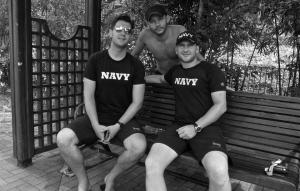The Navyís first foray into Cheung Chau proved a stark reminder of the importance of total focus and regardless of the odds, never give up.
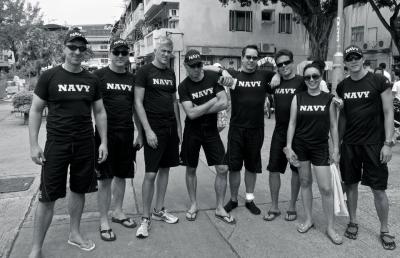 With the Navy well into their off-season recess, thirteen (soon to be reduced to twelve) dedicated sailors bravely answered the call of duty. Some crawled out of bed while others crawled directly out from the treacherous jungles of Wan Chai. From all corners of Hong Kong they came and made their way to the rendezvous point to ready themselves for uncharted waters. It was the Navyís first mission into Cheung Chau, there were many unknown factors including race start sequence, scoring system, and the location of the nearest toilets.
With the Navy well into their off-season recess, thirteen (soon to be reduced to twelve) dedicated sailors bravely answered the call of duty. Some crawled out of bed while others crawled directly out from the treacherous jungles of Wan Chai. From all corners of Hong Kong they came and made their way to the rendezvous point to ready themselves for uncharted waters. It was the Navyís first mission into Cheung Chau, there were many unknown factors including race start sequence, scoring system, and the location of the nearest toilets.
As a smaller race, the organizers wasted no time in proceeding from round to round; there was little time for strategy discussion and warm-ups. With the course being a very short 200m distance, adjustments were made to the start sequence in order to accelerate the boat as fast as possible to keep up with the locals renowned for their lightning-quick starts.
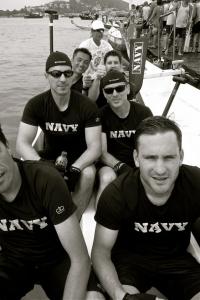
 In the first round, the usual lane introductions were made and officials spent a few moments to line the boats up. With barely a READY announcement, the buzzer went off and the Navy kicked into action. The first 10 start strokes accelerated at an incredible pace and the following 15 egg-beaters were even faster to keep the coffin-like boat in close contention with the leading 2 teams. Entering the chug phase of the strategy, the rating remained high and each stroke felt long and deep. As the team approached the 40 stroke count, the power drop-off experienced in previous races made another appearance. The last 10 strokes proved to be quite a struggle as the boat crossed the finish line. With no finish buzzers heard, it was difficult to gauge when the race ended. There is only one way to handle this, DO NOT STOP! Well, donít stop until the whole boat crosses the line.
In the first round, the usual lane introductions were made and officials spent a few moments to line the boats up. With barely a READY announcement, the buzzer went off and the Navy kicked into action. The first 10 start strokes accelerated at an incredible pace and the following 15 egg-beaters were even faster to keep the coffin-like boat in close contention with the leading 2 teams. Entering the chug phase of the strategy, the rating remained high and each stroke felt long and deep. As the team approached the 40 stroke count, the power drop-off experienced in previous races made another appearance. The last 10 strokes proved to be quite a struggle as the boat crossed the finish line. With no finish buzzers heard, it was difficult to gauge when the race ended. There is only one way to handle this, DO NOT STOP! Well, donít stop until the whole boat crosses the line.
Despite a good first-round effort, another boat had managed to edge past to push the Navy into a 4th place finish. As the organizers did not believe in publishing (or possibly even record) finish times, it was impossible to know the time spread between boats.
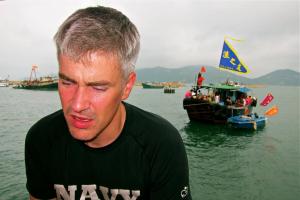 Although it felt like a decent start to the day, there were 3 observers, each with a distinct vantage point, giving the exact same criticism. The hired helmsman, hired gun (literally, he was from the police team to fill in a disappointing vacancy), and land spectator each observed the rating as being too high. The Navy would have to reduce the rating to allow deeper and longer strokes to properly leverage their hung-over fueled powers.
Although it felt like a decent start to the day, there were 3 observers, each with a distinct vantage point, giving the exact same criticism. The hired helmsman, hired gun (literally, he was from the police team to fill in a disappointing vacancy), and land spectator each observed the rating as being too high. The Navy would have to reduce the rating to allow deeper and longer strokes to properly leverage their hung-over fueled powers.
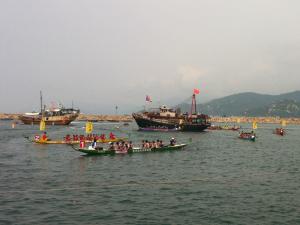 The second round quickly followed. Further adjustments to race strategy were made, only 10 egg-beaters and a reduction in rating to allow for more effective paddling. Unfortunately, disaster would strike and the effectiveness of the changes would go untested. From the moment the boats lined up along the starting blocks, there would be not a single word uttered from the officials. Maybe the sailor in stroke-position was admiring the indigenous people of Cheung Chau or thinking about a Fosters on such a hot summer day, he simply did not notice all boats in ready position. The buzzer suddenly went off and the Navy was caught with their pants down (not the good kind). It would take 2 strokes to get the team fully coordinated and back into the race. The Navy put on a show of impressive mental resiliency as they quickly recovered from the missed start and implemented the slower rating strategy. The team made a valiant effort to power the boat forward to finish in 4th position again.
The second round quickly followed. Further adjustments to race strategy were made, only 10 egg-beaters and a reduction in rating to allow for more effective paddling. Unfortunately, disaster would strike and the effectiveness of the changes would go untested. From the moment the boats lined up along the starting blocks, there would be not a single word uttered from the officials. Maybe the sailor in stroke-position was admiring the indigenous people of Cheung Chau or thinking about a Fosters on such a hot summer day, he simply did not notice all boats in ready position. The buzzer suddenly went off and the Navy was caught with their pants down (not the good kind). It would take 2 strokes to get the team fully coordinated and back into the race. The Navy put on a show of impressive mental resiliency as they quickly recovered from the missed start and implemented the slower rating strategy. The team made a valiant effort to power the boat forward to finish in 4th position again.
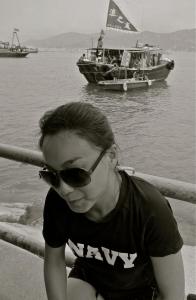 With two 4th place finishes, the Navy still managed to qualify for the Gold Plate final. After a local lunch meal experience we moved back to camp with the intention to rest, just to realize that the finals were already in progress. In that round, not wanting to make the same mistake twice, the team immediately went into ready positions upon reaching the start blocks. This time, there was a minor announcement that the race was ready to start. When the buzzer suddenly went off again, the team reacted well with controlled 10 aggressive start strokes followed by 10 controlled egg-beaters that resulted in a truly competitive start. The rating in the chug piece proved to be most satisfying of all. With a slightly slower rating, each sailor was given the opportunity to get the most out of each stroke. The problems with the power drop-off were nowhere to be seen as the boat maintained a consistent speed to be the first across the finish line.
With two 4th place finishes, the Navy still managed to qualify for the Gold Plate final. After a local lunch meal experience we moved back to camp with the intention to rest, just to realize that the finals were already in progress. In that round, not wanting to make the same mistake twice, the team immediately went into ready positions upon reaching the start blocks. This time, there was a minor announcement that the race was ready to start. When the buzzer suddenly went off again, the team reacted well with controlled 10 aggressive start strokes followed by 10 controlled egg-beaters that resulted in a truly competitive start. The rating in the chug piece proved to be most satisfying of all. With a slightly slower rating, each sailor was given the opportunity to get the most out of each stroke. The problems with the power drop-off were nowhere to be seen as the boat maintained a consistent speed to be the first across the finish line.
Despite being on unfamiliar territory and a 2nd round setback, Navy discipline was on display in fine form as most sailors were able to put it all behind them, put in a full effort, and secure an incredible 1st place finish in a closely contested field. Since the supply of Fosters celebratory fuel was tapped dry in previous missions, Blue Girl was deemed to be an acceptable replacement. No, just kidding, that stuff is disgusting, and herewith eliminated from our fuel supply for good.
Quiz question: can you spot the difference between the following two podium picutures?
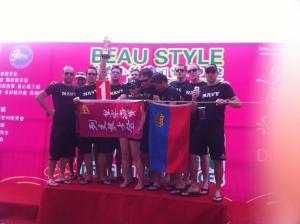

 With the Navy well into their off-season recess, thirteen (soon to be reduced to twelve) dedicated sailors bravely answered the call of duty. Some crawled out of bed while others crawled directly out from the treacherous jungles of Wan Chai. From all corners of Hong Kong they came and made their way to the rendezvous point to ready themselves for uncharted waters. It was the Navyís first mission into Cheung Chau, there were many unknown factors including race start sequence, scoring system, and the location of the nearest toilets.
With the Navy well into their off-season recess, thirteen (soon to be reduced to twelve) dedicated sailors bravely answered the call of duty. Some crawled out of bed while others crawled directly out from the treacherous jungles of Wan Chai. From all corners of Hong Kong they came and made their way to the rendezvous point to ready themselves for uncharted waters. It was the Navyís first mission into Cheung Chau, there were many unknown factors including race start sequence, scoring system, and the location of the nearest toilets.
 In the first round, the usual lane introductions were made and officials spent a few moments to line the boats up. With barely a READY announcement, the buzzer went off and the Navy kicked into action. The first 10 start strokes accelerated at an incredible pace and the following 15 egg-beaters were even faster to keep the coffin-like boat in close contention with the leading 2 teams. Entering the chug phase of the strategy, the rating remained high and each stroke felt long and deep. As the team approached the 40 stroke count, the power drop-off experienced in previous races made another appearance. The last 10 strokes proved to be quite a struggle as the boat crossed the finish line. With no finish buzzers heard, it was difficult to gauge when the race ended. There is only one way to handle this, DO NOT STOP! Well, donít stop until the whole boat crosses the line.
In the first round, the usual lane introductions were made and officials spent a few moments to line the boats up. With barely a READY announcement, the buzzer went off and the Navy kicked into action. The first 10 start strokes accelerated at an incredible pace and the following 15 egg-beaters were even faster to keep the coffin-like boat in close contention with the leading 2 teams. Entering the chug phase of the strategy, the rating remained high and each stroke felt long and deep. As the team approached the 40 stroke count, the power drop-off experienced in previous races made another appearance. The last 10 strokes proved to be quite a struggle as the boat crossed the finish line. With no finish buzzers heard, it was difficult to gauge when the race ended. There is only one way to handle this, DO NOT STOP! Well, donít stop until the whole boat crosses the line. Although it felt like a decent start to the day, there were 3 observers, each with a distinct vantage point, giving the exact same criticism. The hired helmsman, hired gun (literally, he was from the police team to fill in a disappointing vacancy), and land spectator each observed the rating as being too high. The Navy would have to reduce the rating to allow deeper and longer strokes to properly leverage their hung-over fueled powers.
Although it felt like a decent start to the day, there were 3 observers, each with a distinct vantage point, giving the exact same criticism. The hired helmsman, hired gun (literally, he was from the police team to fill in a disappointing vacancy), and land spectator each observed the rating as being too high. The Navy would have to reduce the rating to allow deeper and longer strokes to properly leverage their hung-over fueled powers. The second round quickly followed. Further adjustments to race strategy were made, only 10 egg-beaters and a reduction in rating to allow for more effective paddling. Unfortunately, disaster would strike and the effectiveness of the changes would go untested. From the moment the boats lined up along the starting blocks, there would be not a single word uttered from the officials. Maybe the sailor in stroke-position was admiring the indigenous people of Cheung Chau or thinking about a Fosters on such a hot summer day, he simply did not notice all boats in ready position. The buzzer suddenly went off and the Navy was caught with their pants down (not the good kind). It would take 2 strokes to get the team fully coordinated and back into the race. The Navy put on a show of impressive mental resiliency as they quickly recovered from the missed start and implemented the slower rating strategy. The team made a valiant effort to power the boat forward to finish in 4th position again.
The second round quickly followed. Further adjustments to race strategy were made, only 10 egg-beaters and a reduction in rating to allow for more effective paddling. Unfortunately, disaster would strike and the effectiveness of the changes would go untested. From the moment the boats lined up along the starting blocks, there would be not a single word uttered from the officials. Maybe the sailor in stroke-position was admiring the indigenous people of Cheung Chau or thinking about a Fosters on such a hot summer day, he simply did not notice all boats in ready position. The buzzer suddenly went off and the Navy was caught with their pants down (not the good kind). It would take 2 strokes to get the team fully coordinated and back into the race. The Navy put on a show of impressive mental resiliency as they quickly recovered from the missed start and implemented the slower rating strategy. The team made a valiant effort to power the boat forward to finish in 4th position again. With two 4th place finishes, the Navy still managed to qualify for the Gold Plate final. After a local lunch meal experience we moved back to camp with the intention to rest, just to realize that the finals were already in progress. In that round, not wanting to make the same mistake twice, the team immediately went into ready positions upon reaching the start blocks. This time, there was a minor announcement that the race was ready to start. When the buzzer suddenly went off again, the team reacted well with controlled 10 aggressive start strokes followed by 10 controlled egg-beaters that resulted in a truly competitive start. The rating in the chug piece proved to be most satisfying of all. With a slightly slower rating, each sailor was given the opportunity to get the most out of each stroke. The problems with the power drop-off were nowhere to be seen as the boat maintained a consistent speed to be the first across the finish line.
With two 4th place finishes, the Navy still managed to qualify for the Gold Plate final. After a local lunch meal experience we moved back to camp with the intention to rest, just to realize that the finals were already in progress. In that round, not wanting to make the same mistake twice, the team immediately went into ready positions upon reaching the start blocks. This time, there was a minor announcement that the race was ready to start. When the buzzer suddenly went off again, the team reacted well with controlled 10 aggressive start strokes followed by 10 controlled egg-beaters that resulted in a truly competitive start. The rating in the chug piece proved to be most satisfying of all. With a slightly slower rating, each sailor was given the opportunity to get the most out of each stroke. The problems with the power drop-off were nowhere to be seen as the boat maintained a consistent speed to be the first across the finish line. 
